Views
The view controls the type of content that displays in the View Pane, the behavior of the view, and ties together the different pieces of metadata, such as Microsoft Excel templates, Essbase Connections, selectors, selector lists, toolbars and other components needed to display and control a view.
Properties
Appearance
CaptionBeforeBuild is the text that appears on the view tab or title bar when a user opens the view and before the view builds for the first time. If no value is specified, the view name is used as the caption.
CaptionAfterBuild is the text that appears on the view tab or title bar after the view builds or refreshes. If no value is specified, the CaptionBeforeBulid displays. If no CaptionBeforeBuild is specified the view name displays.
Behavior
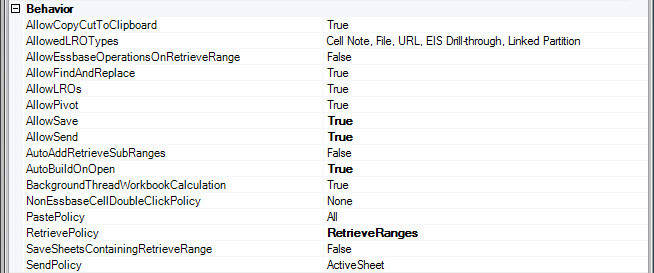
The AllowLROs setting defines whether the Linked Objects Browser dialog appears when a user double-clicks the left mouse button in a data cell. A linked reporting object (LRO) is an object that you associate with a specific data cell in an Analytic Services database; for example, a graphic file that more fully explains a cell value. LROs provide improved support for planning and reporting applications and can enhance data analysis capabilities by providing supplemental information about data. LROs can be linked files, brief cell notes, or URLs. AllowedLROTypes controls the LRO types available in the Linked Objects Browser dialog.
AllowPivot controls whether the user is allowed to initiate an Essbase operation. If True, a user can initiate a pivot operation by pressing the right mouse button in a member cell and the holding and dragging the mouse to the destination cell. The Pivot button tool can also be used to pivot a member. The tool is enabled when the AllowPivot setting is True.
AllowEssbaseOperationsOnRetrieveRange controls whether the user can perform Essbase operations, including Zoom Out, Remove Only, Keep Only, and Pivot on the data that is contained within the retrieve range.
-
When a sheet contains a retrieve range that represents content that has static layout, Essbase operations should not be allowed.
-
When a sheet contains data on which the user can perform adhoc analysis, a retrieve range can be used simply to define the area within the sheet that contains the Essbase data.
-
The AllowPivot setting takes precedence when determining whether a pivot operation is allowed. Example: If AllowEssbaseOperationsOnRetreiveRange is True and *AllowPivot * is False then Zoom In, Zoom Out, Remove Only and Keep Only are allowed but Pivot is not allowed.
AllowSave controls whether a user can save a view. If True, the Save View and Open Saved View buttons are enabled. AllowSend controls whether the user is allowed to update Essbase data by posting changes to the database. If True the Save View and Open Saved View tool buttons are enabled.
Behavior Drillthrough Sheets

AllowLROsOnDrillThroughSheet controls whether the Linked Objects Browser dialog appears when a user double-clicks the left mouse button in a data cell on a drillthrough.
AllowedLROTypesOnDrillThroughSheet controls the LRO types available in the Linked Object Browser dialog for a drillthrough sheet. This option is only applicable when AllowLROsOnDrillThroughSheet is True.
SelectorsVisibleOnDrillThroughSheet controls whether the selectors are visible when a drillthrough sheet is the active sheet. AllowSendOnDrillThroughSheet controls whether the user is allowed to update Essbase data by posting changes to the database with the data from the active drillthrough.
Cascade

CascadeDoCascade controls whether the view is cascaded when built. When the view is cascaded, the list each cascade source defines is obtained or generated. The Cartesian product of the lists is generated and a copy of the cascade template sheet is created for each ordered combination of members. The cascade template sheet is deleted.
The RetrievePolicy should be set to AllSheets if the cascade template does not contain a named retrieve range. The RetrievePolicy should be set to RetrieveRanges if the cascade template does contain a named retrieve range.
A source, with reference to a cascade, is either a selector, which allows the user to select the items of the cascade list or a script which is used to generate the list. CascadeSources defines the source for the views cascade list. Clicking on the ellipses on the CascadeSorces row displays the Cascade Sources Dialog showing Source Type and a list of sources.
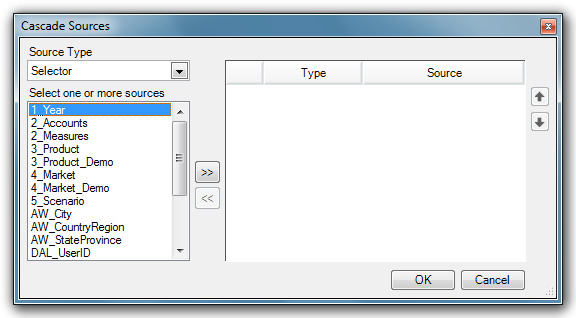
CascadeSheetnamedPattern specifies the tokenized string used to build the name of each cascade sheet and is only applicable when the CascadeDoCascade setting is True. By default, the sheet name contains each of the member names represented by the sheet. For example, if the cascade sources are the selectors for Product, Market and Scenario, and the members represented by the sheet are Cola, New York and Actual, the default sheet name is Cola-New York-Actual.
The CascadeTemplateSheetNumber property specifies the 0-based index of the sheet in the Excel template that is used as the cascade template sheet. CascadeTemplateSheetNumber is only applicable when the CascadeDoCascade setting is True.
SummarySheetAdd controls whether a cascade summary sheet is added to the view. If a summary sheet is added, [T.SummarySheetList] and [T.SummarySheetsRange] will be added to the view’s tokens.
-
SummarySheetName: Specifies the name given to the cascade summary sheet. Summary is the default name.
-
SummarySheetPosition: Specifies the position for the cascade summary sheet. The choices are First , and Last. The default is Last.
-
SummarySheetIncludeSheetAddress: Specifies an address of a boolean value to examine on each cascade sheet to determine if the sheet should be included in the summary.
-
SummarySheetIsSummarySheetAddress: Specifies a cell address where a value of TRUE will be put on the summary sheet.
-
SummarySheetSummaryRangeAddress: Specifies the address of the range to put the summary formulas into.
Charts
ChartRetrieveRangeInfo relates each chart control in the view user-interface to the retrieve range that contains the data represented by that chart.
Clicking on the ellipses after selecting the ChartRetrieveRangeInfo property displays a dialog box.
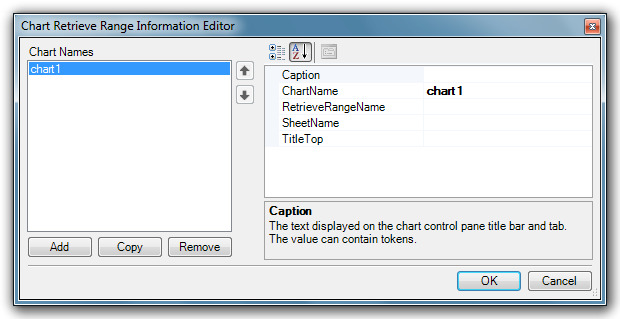
In the dialog, the ChartName is the name of the chart control. The value is used to locate the chart control to fill with the retrieve range data. The value must match the name of an existing chart control. The Caption is the text displayed on the chart control pane title bar and tab. This value can contain tokens. The RetrieveRangeName is the name of the retrieve range that contains the data the chart will represent.
Comments
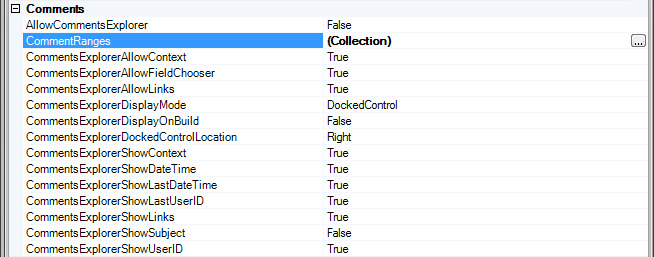
AllowCommentsExplorer controls whether to allow the comments explorer functions.
CommentsExplorereDisplayMode controls whether the comments editor displays in a docked pane or a modal dialog.
-
DockedControl – The comments editor displays in a dockable pane. The CommentExplorerDockedControlLocation specifies the docked location.
-
LockedDockedControl – Same as DockedControl, except that the user cannot move the comments editor to a different docked location.
-
ModalDialog- The comments editor displays in a modal dialog
CommentsExplorerDockedControlLocation is the initial docked location for a dockable comments editor. The setting is only applicable when the *CommentsExplorereDisplayMode * is set to DockedControl or LockedDockedControl.
CommentRanges controls the behavior or comments within each specified comment range. Clicking on the CommentRanges ellipses opens the Comment Range Configuration Editor.
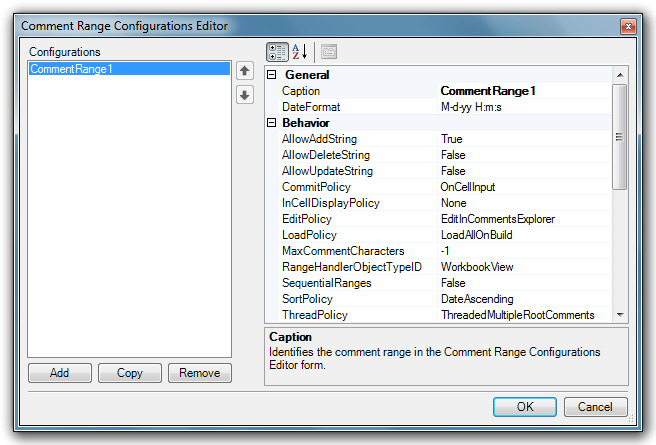
This configurations editor, like the other metadata editors, has required property settings.
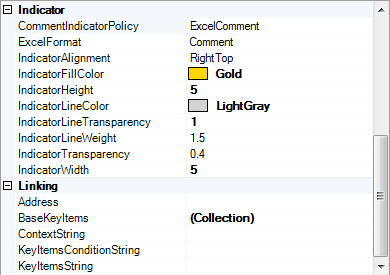
Data Drillthrough

DataCellDoubleClickPolicy controls what happens when the user double-clicks an Essbase data cell with the left mouse button.
-
None: Nothing happens.
-
ShowLROsDialog: The linked Objects Browser display. For an Essbase view, if the policy is ShowLROsDialog and the AllowLROs setting is False, the dialog displays regardless of the AllowLROs setting.
-
EnterEditMode: The cursor displays in the cell and allows the user to edit the value.
-
AddSheetForDrillthrough: A sheet is added that contains the members that intersect at the data point represented by the data cell. The user can perform ad hoc analysis on the drillthrough sheet.
-
OpenViewForDrillthrough: Opens the view specified by the DataDrillthroughViewID setting.
DataCellDoubleClickMemberFilters controls whether the action the DataCellDoubleClickPolicy defines is performed based on the level number, level name, member name or UDS of the contributing members.
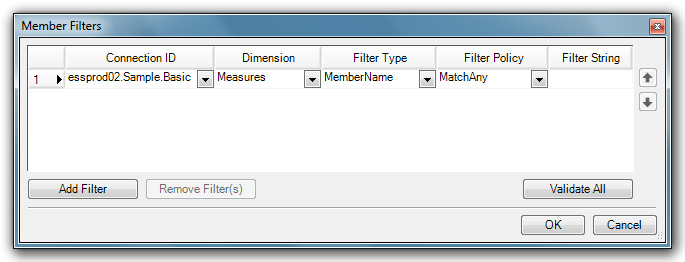
DataDrillthroughSheetName indicates the base name used for a drillthrough sheet. A drillthroughsheet is added when the DataCellDoubleClickPolicy is AddSheetForDrillThrough and the user double-clicks a data cell with the left mouse button. When a drillthrough sheet is added, the sheet name is constructed using the DataDrillthroughSheetName. If other drillthrough sheets exist, the name is appended with a number of the copy in parenthesis. This is the same naming convention used by Microsoft Excel when a sheet is copied. The DataDrillThroughSheetName can be tokenized. By default, this setting is empty. When the setting is empty, the name of a drillthrough sheet is a concatenated list (delimited by dashes) of the members that intersect the data cell. Example: East – Actual – Qtr 1- Sales – Cola.DataDrillthroughSheetName is only applicable when the DataCellDoubleClickPolicy is AddSheetForDrillthrough.
DataDrillthroughSheetNameMaxLength controls the maximum length of a drillthrough sheet name. The default setting is 31, which is the maximum number of characters allowed by Microsoft Excel for a sheet name. When the view is to be saved to Microsoft Excel, use the default setting. DataDrillthroughSheetNameMaxLength is only applicable when the DataCellDoubleClickPolicy is AddSheetForDrillthrough.
DataDrillthroughViewID indicates the ID of the view that is open when the DataCellDoubleClickPolicy is OpenViewForDrillthrough and the user double-clicks a data cell with the left mouse button.
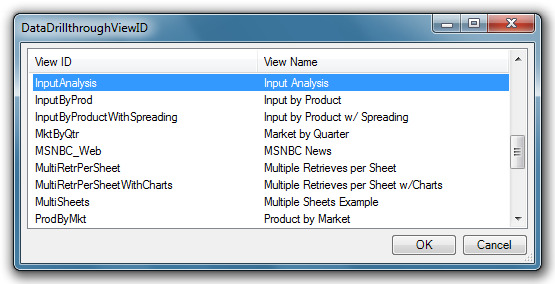
Every Token that a selector defines for a dimension whose member contributes to the data cell is passed as a view token to the drillthrough view using the ViewTokens. Since ViewTokens is used to set the default selections for the drillthrough view, both views can represent the same Essbase data (as appropriate). DataDrillthroughViewID is only applicable when the DataCellDoubleClickPolicy is OpenViewForDrillthrough.
When the DataCellDoubleClickPolicy is OpenViewForDrillthrough, EnforceEssbaseFilterOnOpenViewForDrillthrough controls whether the view is opened when an Essbase filter prevents the user from accessing the data cell. If the setting is True, the view is not opened when the user has no access to the data cell. If the setting is False, the view is opened whether or not the user has access to the data cell.
Essbase Connection
EssbaseConectionID is the Essbase connection ID used to look up the connection metadata that defines the Essbase connection setting for the view. The EssbaseLoginServiceObjectTypeID is the object type ID of the login service that obtains the credentials necessary to sign on to the Dodeca Essbase service.
Essbase Options
AllowUserEssbaseOptions controls whether a user’s Essbase options settings are used instead of the Essbase option settings that are defined for this view, which are represented by the EssProperty settings. When used in conjunction with the AllowedUserEssbaseOptions setting, an administrator can control which Essbase options a user is allowed to set. AllowedUserEssbaseOptions controls the Essbase options that a user is allowed to set.
RetrainOnRetrieval controls whether formulas within the retrieve range are retained when building or refreshing the view and during a retrieve operation.
UserEssbaseOptionsContext controls the caching of the user’s Essbase Options settings. The cache is used to initialize the settings when a view is opened.
-
None: The user’s settings are not cached. When a user opens the view, the settings are assigned a default value based on the EssProperties settings.
-
Global: The user’s settings are shared by all views configured with a global context. Any changes the user makes to the settings are applied to the current view and to other views that are subsequently opened that are also configured with a UserEssbaseOptionsContext setting of Global.
-
_ByView: _ The user’s settings only apply to instances of this view. When the view is opened, the settings are initialized to the settings most recently used by an instance of this view.
-
ByLabel: _ The user’s settings are shared by all views configured with a ByLabel context and assigned the same label as the view. Any changes the user makes to the settings are applied to the current view and to other views that are subsequently opened that are also configured with a UserEssbaseOptionsContext setting of _ByLabel with the same UserEssbaseOptionsContextLabel.
Excel Template
This field contains the ID and version number of the Binary artifact that contains the Microsoft Excel template associated with the view. Clicking the ellipses displays the Select Excel Template Binary Artifact dialog containing a list of available Binary Artifacts.
Export to Excel
When the user exports the view to Microsoft Excel, each protected worksheet is password protected with the ExportToExcelProtectedWorksheetPassword value in order to prevent a user from unprotecting a worksheet in the Microsoft Excel file.
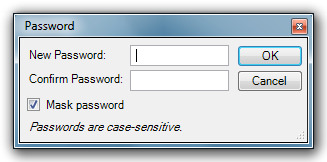
Grid Properties

GridLinesVisible controls whether the grid lines are visible or hidden for template and cascade sheets.
-
Default: The application uses Microsoft Excel grid line visibility settings.
-
True: Grid lines are visible.
-
False: Grid lines are hidden.
GridLinesVisibleOnDrillthroughSheet controls whether the grid lines are visible on a drillthrough sheet.
RowAndColumnHeadersVisible controls whether row and column headers are are visible or hidden for template and cascade sheets.
-
Default: The row and column headers use Microsoft Excel visibility settings.
-
True: Row and column headers are visible.
-
False: Row and column headers are hidden.
RowAndColumnHeadersVisibleOnDrillthroughSheet controls whether row and column headers are visible on a drillthrough sheet.
TabsVisible controls whether sheet tabs are are visible or hidden for template and cascade sheets.
-
Default: The sheet tab uses the Microsoft Excel visibility setting.
-
True: Sheet tabs are visible.
-
False: Sheet tabs are hidden.
Member Drillthrough

MemberCellDoubleClickAllowedDimensions controls whether the action the MemberDoubleClickPolicy defines is performed only for members that belong to a particular dimension or any dimension. If one or more dimensions are specified, each selected member must belong to a specified dimension for the action to be performed.
Clicking the left mouse on the MemberCellDoubleClickAllowedDimensions ellipses opens an Essbase Login dialog.
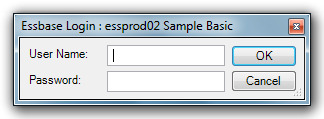
Enter a valid user name and password to access the MemberCellDoubleClickAllowedDimensions dialog.
After choosing an Essbase Connection ID, the administrator can choose allowed dimensions from the list.
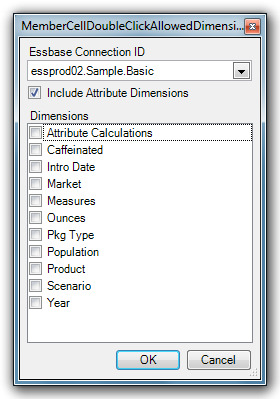
Example: If the MemberCellDoubleClickPolicy is Zoom and the MemberCellDoubleClickAllowedDimensions is Product;Market, then a Zoom In or Zoom Out operation is performed only when the user double-clicks a member(s) that belong to the Product or Market Dimension.
By default, the value is empty, which indicates that the MemberCellDoubleClickPolicy is performed on members belonging in any dimension.
MemberCellDoubleClickAllowedOrientations controls whether the action defined by the MemberCellDoubleClickPolicy applies to page, column and/or row members.
Example: If the MemberCellDoubleClickPolicy is Zoom and the MemberCellDoubleClickAllowedOrientations is Row, then a Zoom In or Zoo Out operation is performed only when the user double-clicks a row member(s), but not when the user double-clicks a page or column member. By default, the value is ALL, which indicates that the MemberCellDoubleClickPolicy is performed for page, row and column members.
Both the MemberCellDoubleClickAllowedOrientations and MemberCellDoubleClickAllowedDimensions settings are used to control whether the action is performed when the user double-clicks a member cell(s).
MemberCellDoubleClickPolicy controls what happens when the user double-clicks an Essbase member cell with the mouse button.
-
None: Nothing happens.
-
Zoom: The application performs a zoom in operation when the left mouse button double-clicked and it performs a zoom out operation when the right mouse button is double-clicked.
-
EnterEditMode: The cursor displays in the cell and the user can edit the value.
Selectors

SelectorConfiguration configures the selectors for the view, including the order the selectors display in the tool bar. Clicking on the ellipses at the SelectorConfiguration row display a Configure Selectors dialog.

In the dialog there are a number of configurable settings for each selector.
-
Optional: Controls whether a selection is optional or required.
-
Multi-Select: Controls whether the user is allowed to select multiple items or only a single item. If checked, users can selection multiple items.
-
Caption: An optional caption that overrides the default caption defined for the selector.
-
Selector List: the selector list that defines how the user list of selectable items is generated and is the user-interface control used to display the items. If no selector list is specified, the application uses the default selector list defined for the selector.
-
Last Used Item Context: Controls the caching of the item(s) selected when the view is built or refreshed.
-
Last Used Item Context Label: The context label used when the Last Used Item Context is set to ByLabel.
-
Connection Policy: For a selector that requires a connection to generate a list of selectable items, the connection policy controls whether the selector uses the view’s connection or uses a specific connection.
-
Connection Settings: When the connection policy is UseSpecificConnection, the connection settings identify and configure the connection.
The SelectorControlDisplayMode controls whether a docked pane or a modal dialog contains the user-interface control that displays the selectable items. The setting is only applicable to selectors that display the items in a user-interface control, such as a treeview or listbox, when the user clicks the Show button on the selector tool.
-
DockedControl: Displays a pane that contains the user-interface control. The pane is docked the first time the user clicks the Show button.
-
LockedDockControl: Same as DockedControl, except that the user cannot move the control to a different docked location.
-
ModalDialog: Displays a modal dialog hat contains the user-interface control. The dialog displays each time the user clicks the Show button. The user must close the dialog.
The SelectorDockedControlGroupStyle is the layout of the group of dockable selector user interface controls. The setting is only applicable when the SelectorControlDisplayMode is set to DockedControl.
-
Tabbed: Each selector control displays as a tabbed window within the group. Only the content of the selector control that displays in the active tab is visible.
-
Stacked: The selector controls display as stacked tiles.
-
SlidingHeaders: Each selector control is represented by a button and only the content of the active selector control is visible. A selector control is activated by pressing the button.
-
SideBySide: The selector controls display as side-by-side tiles.
The SelectorDockedLocation is the initial docked location for dockable selector user interface controls. The setting is only applicable when the SelectorControlDisplayMode is set to DockedControl.
SelectorLastUsedItemContext controls the caching of the items selected when the view is built or refreshed. The cache determines the default selected item for the selectors that are assigned a selector list with a DefaultSelectionPolicy of LastUsedItem.
-
BySelector: The cache is shared by all views configured with the BySelector context.
-
ByView: The cache is used only by this view.
-
ByLabel: The cache is shared by all views configured with the ByLabel context and assigned the same SelectorLastUsedItemContextLabel as the view.
Tokens
ViewTokens represents the token definitions assigned to the view. Clicking on the ellipses display the Token Editor dialog that allows you to add, remove and edit the available tokens.
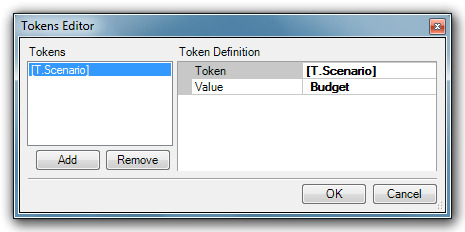
UI

The GridContextMenuID is the key to the PopupMenuTool to use as the context menu for the grid control. The GridContextMenuForDrillthroughSheet is the key of the PopupMenuTool to use as the context menu for the grid control when the active worksheet is a drillthrough sheet. Any popup menu that is defined in the toolbars configuration assigned to the ViewToolbarsConfigurationID can be used as the grid context menu.
MergableToolbarsConfigurationID is the ID of the toolbar configuration that defines the view-specific menus and tools. At run-time, the menus and tools are merged with the application menus and tools providing the view with the look of a single set of tools and menus.
ViewToolbarsConfigurationID is the ID of the toolbar configuration that defines the view-specific menus and tools displayed within the view window.
WindowsViewUIObjectTypeID is the object type ID of the Microsoft Windows form that contains the user interface controls used to display the view data. This is a required setting.
Remarks
For a good step by step example of adding a view, go back and review; Creating a New Essbase Ad Hoc View Definition.